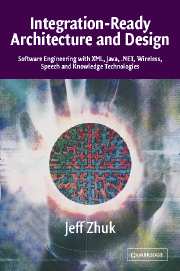 Integration-Ready Architecture and Design
Integration-Ready Architecture and Design Book contents
- Frontmatter
- Contents
- Preface
- Contributors
- Acknowledgments
- Introduction
- Notes for Educators: AMA Teaching Methods
- Chapter 1 Collaborative Engineering
- Chapter 2 Software Architecture and Integration Technologies
- Chapter 3 From a Specific Task to “Integration-Ready” Components
- Chapter 4 Integration with Voice
- Chapter 5 An Introduction to Knowledge Technologies
- Chapter 6 Write Once
- Chapter 7 The New Generation of Client–Server Software
- Chapter 8 Wireless Technologies
- Chapter 9 Programming Wireless Application Protocol Applications
- Chapter 10 A Single JavaCard Identity Key for All Doors and Services
- Chapter 11 The J2ME Family
- Chapter 12 Speech Technologies on the Way to a Natural User Interface
- Chapter 13 Integration with Knowledge
- Chapter 14 Distributed Life in the JXTA and Jini Communities
- Appendix 1 Java and C#: A Saga of Siblings
- Appendix 2 XML and Web Services
- Appendix 3 Source Examples
- Index
Chapter 7 - The New Generation of Client–Server Software
Published online by Cambridge University Press: 17 August 2009
- Frontmatter
- Contents
- Preface
- Contributors
- Acknowledgments
- Introduction
- Notes for Educators: AMA Teaching Methods
- Chapter 1 Collaborative Engineering
- Chapter 2 Software Architecture and Integration Technologies
- Chapter 3 From a Specific Task to “Integration-Ready” Components
- Chapter 4 Integration with Voice
- Chapter 5 An Introduction to Knowledge Technologies
- Chapter 6 Write Once
- Chapter 7 The New Generation of Client–Server Software
- Chapter 8 Wireless Technologies
- Chapter 9 Programming Wireless Application Protocol Applications
- Chapter 10 A Single JavaCard Identity Key for All Doors and Services
- Chapter 11 The J2ME Family
- Chapter 12 Speech Technologies on the Way to a Natural User Interface
- Chapter 13 Integration with Knowledge
- Chapter 14 Distributed Life in the JXTA and Jini Communities
- Appendix 1 Java and C#: A Saga of Siblings
- Appendix 2 XML and Web Services
- Appendix 3 Source Examples
- Index
Summary
Divide and rule, a sound motto. Unite and lead, a better one.
—Johann Wolfgang von Goethe (1749–1832)This chapter is about existing and upcoming client–server paradigms in communications, the distribution of computing power, and effective programming with reusable code that can be run on both sides of the client–server pair.
The past decade of client–server development turned to the server part of this happily married couple. The biggest software giants are in a hurry to translate desktop applications into Web services leased or sold on a pay-per-use basis.
This work, begun several years ago, was based on several assumptions:
Client networks will improve/upgrade faster and more cheaply than client computers.
HTTP-based Web technology will be able to provide all or most of the requested services.
Centralized data and services will benefit clients and service providers.
Unfortunately, not all of these assumptions happen to be true.
Computers and PDAs are much more capable and cheap today than they were several years ago, whereas digital subscriber line (DSL) and cable modems are still the same price, with no miracles to show for it.
One of the biggest requests for Internet services, streaming data, requires protocols other than HTTP and lies outside of Web technology. (This is just one example; applications with asynchronous natures are also not comfortable with HTTP limitations.)
Groups of clients are unhappy with the centralized service concept. For security reasons, they prefer peer-to-peer or similar communications.
[…]
- Type
- Chapter
- Information
- Integration-Ready Architecture and DesignSoftware Engineering with XML, Java, .NET, Wireless, Speech, and Knowledge Technologies, pp. 222 - 256Publisher: Cambridge University PressPrint publication year: 2004
